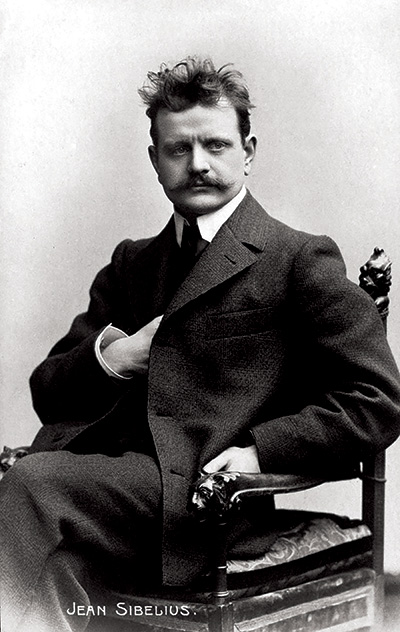Jean Sibelius

- Born: December 8, 1865, Hämeenlinna, Finland
- Died: September 20, 1957, Ainola Järvenpää, Finland
Symphony No. 2 in D Major, Op. 43
- Composed: 1901
- Premiere: March 8, 1902, Helsinki, Jean Sibelius conducting the Helsinki Orchestral Society
- Instrumentation: 2 flutes, 2 oboes, 2 clarinets, 2 bassoons, 4 horns, 3 trumpets, 3 trombones, tuba, timpani, strings
- CSO notable performances: First Performance: February 1912, Leopold Stokowski conducting. Most Recent Performance: October 2013, Rafael Payare conducting. Other: The CSO released the Symphony No. 2 in 2002 on its Sibelius/Tubin CD, Paavo Järvi conducting.
- Duration: approx. 43 minutes
Jean Sibelius was much more than Finland’s most famous composer. For the Finns, he was, and still is, a national hero who expressed what was widely regarded as the essence of the Finnish character in music. In his symphonic poems, Sibelius drew on the rich tradition of the ancient Finnish epic, the Kalevala. And in his seven symphonies he developed a style that has come to be seen as profoundly Finnish and Nordic. It was a logical continuation of the late Romantic tradition inherited from Brahms, Grieg and Tchaikovsky, and, at the same time, a highly personal idiom to which he clung steadfastly in the midst of a musical world filled with an increasing multiplicity of new styles.
Each of Sibelius’s symphonies has its own personality. The Second is distinguished by a predilection for melodies that sound like folksong—although Sibelius insisted that he had not used any original folk melodies in the Symphony. We know, however, that he was interested in the traditional music of his country and, in 1892, he visited Karelia, the Eastern province of Finland known for the archaic style of its songs. It was perhaps this avowed interest in folksong that prompted commentators to suggest a patriotic, political program for the Symphony. None other than the conductor Georg Schnéevoigt, a close friend of Sibelius’s and one of the most prominent early performers of his music, claimed that the first movement depicted the quiet pastoral life of the Finnish people and that subsequent movements represented, in turn, the Russian oppressors, the awakening of national resistance, and, finally, the triumph over foreign rule. These ideas were certainly timely at the turn of the century, when Finland was in fact ruled by the Czar, though Sibelius himself never claimed to have had an extra-musical program in mind. (But neither did he disavow Schnéevoigt’s interpretation.)
In the first movement, Sibelius “teases” the listener by introducing his musical material by bits and pieces and taking an unusually long time to establish connections among the various short motifs introduced. The gaps are filled in only gradually. Eventually, however, the outlines of a symphonic form become evident and by the end of the movement everything falls into place. In his 1935 book on Sibelius’s symphonies, British composer and critic Cecil Gray observed:
…whereas in the symphony of Sibelius’s predecessors the thematic material is generally introduced in an exposition, taken to pieces, dissected, and analysed in a development section, and put together again in a recapitulation, Sibelius in the first movement of the Second Symphony inverts the process, introducing thematic fragments in the exposition, building them up into an organic whole in the development section, then dispersing and dissolving the material back into its primary constituents in a brief recapitulation.
The second movement (Tempo andante, ma rubato) opens in an exceptional way: a timpani roll followed by an extended, unaccompanied pizzicato (plucked) passage played in turn by the double basses and the cellos. This gives rise to the first melody, marked lugubre (mournful) and played by the bassoons (note the exclusive use of low-pitched instruments). Slowly and hesitatingly, the higher woodwinds and strings enter. Little by little, both the pitch and the volume rise, and the tempo increases to poco allegro, with a climactic point marked by fortissimo chords in the brass. As a total contrast, a gentle violin melody, played triple pianissimo (ppp) and in a new key, starts a new section. The lugubre theme, its impassioned offshoots, and the new violin melody, dominate the rest of the movement. The movement ends with a closing motif derived from this last melody, made more resolute by a fuller orchestration.
The third movement (Vivacissimo) is a dashing scherzo with a short and languid trio section. The singularity of the trio theme, played first by the oboe, is that it begins with a single note repeated no less than nine times, yet it is immediately perceived as a melody. The rest of the theme is eminently melodic, with a graceful tag added by the two clarinets. After a recapitulation of the scherzo proper, the trio is heard another time, followed by a masterly transition that leads directly into the triumphant Finale.
The first theme of the Finale is simple and pithy; it is played by the strings, with forte (loud) dynamics, to a weighty accompaniment by low brass and timpani. The haunting second theme has a four-line structure found in many folksongs; it is played by the woodwinds, much more softly than the first theme, though eventually rising in volume. After a short development section, the triumphant first theme and the folksong-like second both return. Repeated several times with the participation of ever greater orchestral forces, the second theme builds up to a powerful climax. The first theme is then restated by the full orchestra as a concluding gesture.
—Peter Laki